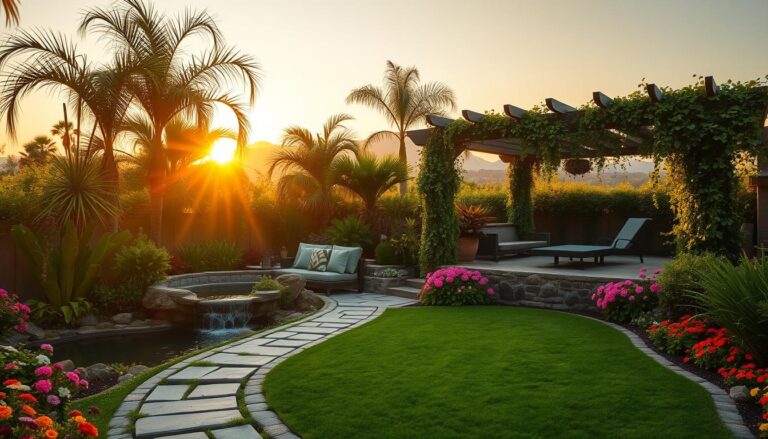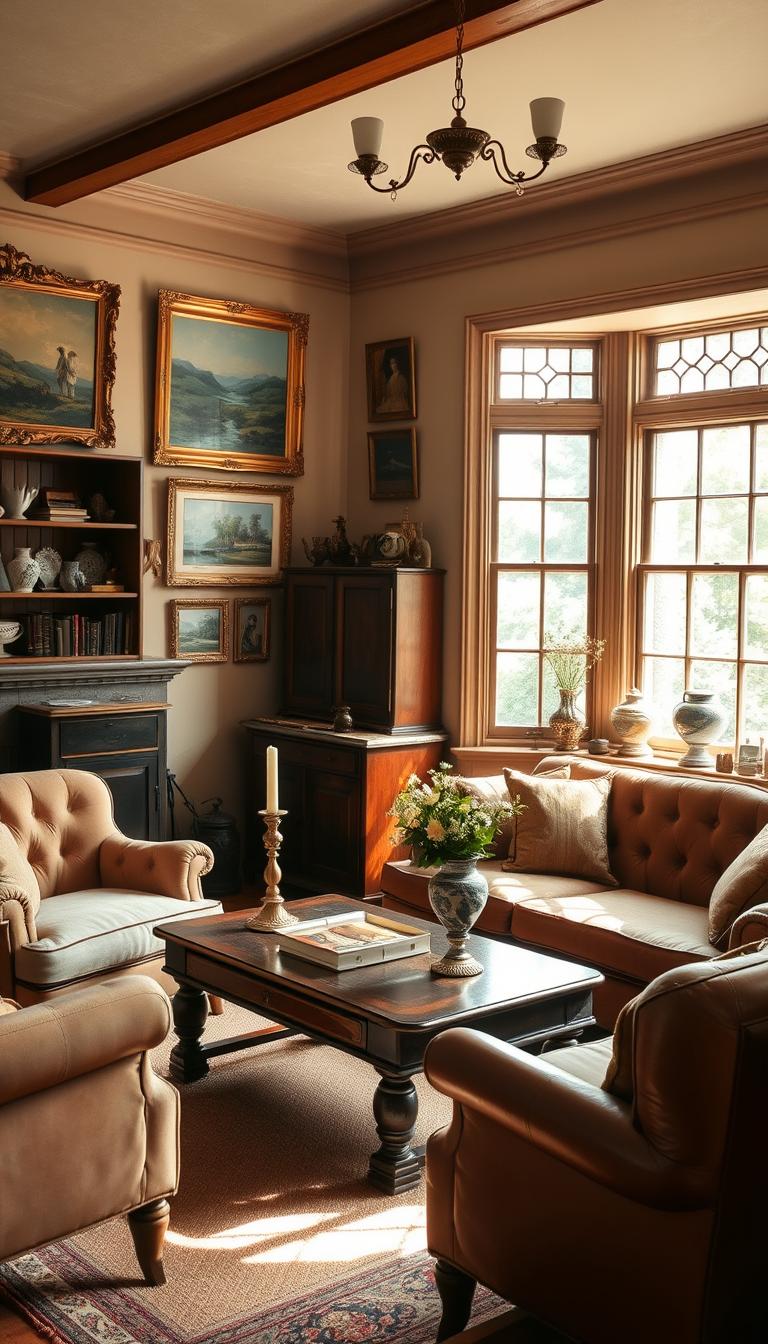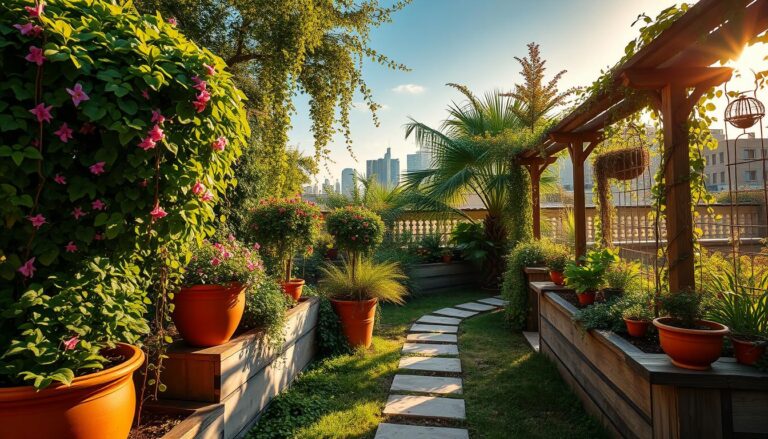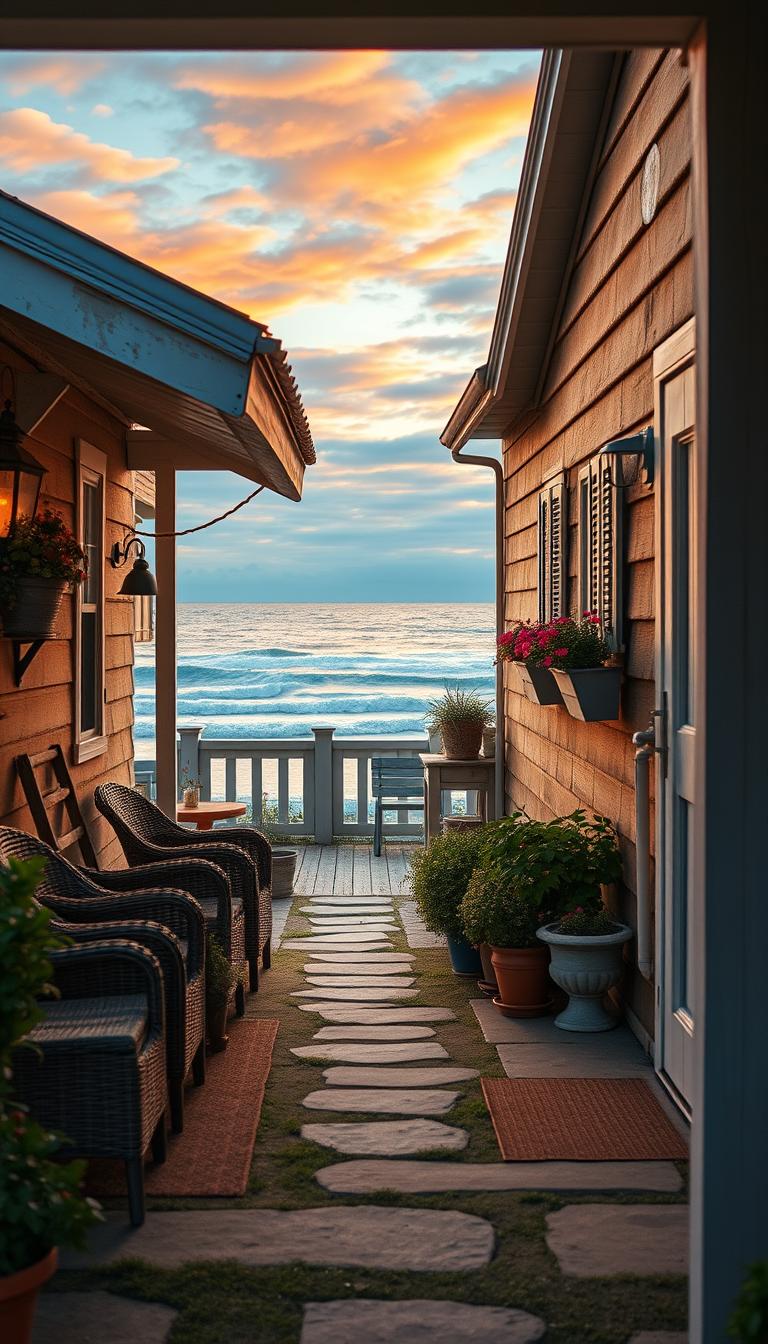The Best Antique Garden Ideas For This Summer
This post contains affiliate links, meaning I may receive a small commission if you make a purchase through my links, at no extra cost to you.
Imagine a garden that feels like it’s been around for decades. It’s not just for this season. Picture stepping into a space where old wood, rusty metal, and Grandma’s flowers come together. That’s what an antique garden is all about.
It’s where every piece tells a story of history and warmth. You might use an old galvanized tub as a planter1 or let Grandma’s roses climb an old trellis2. These choices make your vintage garden a living history.
An antique garden invites you to slow down. Imagine sipping lemonade on a rusty bench1 while dahlias dance around a whiskey barrel planter1. It’s not just about looks; it’s about feeling at home in history.
Even small yards can be beautiful with a rusty milk can1 or a salvaged window border1. Charm doesn’t need a lot of space.
These elements resonate because they connect us to timeless beauty.
A weathered fountain1 or a wrought-iron bistro set3 brings instant nostalgia. Peonies blooming2 with old garden tools1 turns yards into cherished places. This summer, let your garden tell a story only time can write.
Key Takeaways
- Repurpose items like galvanized buckets and rusty garden tools to add instant vintage charm1.
- Combine heirloom plants like hydrangeas with weathered wood elements for layered beauty2.
- Vintage iron benches and cast aluminum trellises merge function with timeless style3.
- Use reseeded annuals like cosmos to create low-maintenance, nostalgic color bursts2.
- Even small spaces thrive with salvaged elements like antique windows or reclaimed garden edging1.
Embracing the Charm of an Antique Garden in Modern Times

Antique gardens mix old-world charm with today’s needs. They offer a peaceful retreat, inspired by the Victorian era and Edwardian era. These gardens combine order with nature’s beauty, inviting you to discover their beauty.
By following their design, you can create a garden that feels both timeless and personal.
Understanding the Timeless Appeal of Vintage Gardens
Victorian and Edwardian gardens love symmetry and decoration. They feature cottage garden influence with flower-filled borders and trellises. Glasshouses and urns add elegance, while roses and trees add depth4.
These gardens show a love for plants and history, making them like living museums.
How Antique Garden Elements Connect to Nature
Old-world gardens respect nature. Gravel paths mark areas without harming the soil, and wildflowers attract pollinators5. Using old materials for planters shows care for the planet and honors cottage traditions45.
Features like ivy-covered arbors support climbing plants, boosting biodiversity.
Finding Your Personal Vintage Garden Style
- Mix Victorian order with cottage garden freedom using heirloom flowers like foxgloves and lavender5.
- Use old tools, like rusted wheelbarrows with petunias or a repainted bench5.
- Combine tradition with modern needs: choose easy-to-care-for plants and new irrigation systems.
Whether you prefer the Edwardian’s mix of formality and ease or the cottage garden’s wild beauty, these styles fit your life. Let history inspire you, but make your garden uniquely yours.
Victorian-Era Garden Design Principles to Implement This Season
Victorian gardens were a mix of grandeur and nature’s beauty. Start by using garden structures like cast iron gates or herringbone brick paths. This creates a structured yet inviting layout6.
Winding paths guide visitors past focal points like topiary sculptures or ornate fountains. These paths let you discover blooms and ornaments slowly. This enhances the sense of exploration7.

Topiary adds drama without overwhelming smaller spaces. Trim boxwood into simple shapes, then soften edges with climbing roses. This mirrors Victorian mastery over nature while staying low-maintenance8.
For paths, mix gravel with geometric tiles bordered by rope edging. This combines formal garden structures with cottage-style flower profusion. It’s a key Victorian balance6.
- Use wrought iron fencing or trellises to frame garden rooms, adding vertical interest.
- Incorporate mature trees like wisteria to cast dappled shade and anchor borders7.
- Add romantic touches like cast iron benches or obelisks to highlight key plants8.
Even small gardens can channel Victorian charm. Layer plants in tiers—tall delphiniums at the back, mid-height hydrangeas, and low marigolds in flowerbeds. This mimics Gertrude Jekyll’s texture-focused borders6.
Lighting with lanterns or solar-powered garden structures extends enjoyment into evenings7.
Focus on balance: let structured topiary contrast with wilder cottage plantings. This duality creates the maximalist appeal Victorians adored8. With these principles, you’ll craft a garden that’s both timeless and tailored to your space.
Ornamental Ironwork: Adding Elegance and Structure

Introduce ornamental ironwork to your garden for a mix of history and function. Items like gates, benches, and trellises bring timeless beauty. They also support plants and define areas. Iron’s rustic charm unifies every element, whether you’re restoring or creating anew.
Victorian Gates and Fences for Garden Definition
Victorian gates and fences made from ornamental ironwork boost your garden’s look. Designs like fleur de lis, common in New Orleans, add cultural touch and durability9. Look for designs with floral motifs or scrollwork to frame your garden’s entrance. Brands like YouFine Sculpture offer affordable, historically-inspired pieces10.
Pair these gates with climbing roses or clematis. This lets greenery soften the metal’s look.
Decorative Iron Benches and Seating Areas
Iron benches serve as both seats and decorative pieces. Opt for ones with openwork backs or scrolled arms for a Victorian touch. Place them under shade trees or near flowerbeds for a pleasant spot. Rustic finishes add charm without overwhelming the area10.
Trellises and Supports for Summer Climbing Plants
Ornamental iron trellises are great for training vines like wisteria or grapes. They support heavy growth and add vertical interest. Combine them with rustic elements like weathered posts or stone bases for a cohesive look. YouFine offers a range of trellis options and vintage-inspired supports for climbing plants10.
Blend salvaged pieces with modern reproductions for a unique look. Check local antique shops or online for items like finials or lattice panels. Over time, iron’s patina develops a charm that fits any garden style9.
Classic Pathways: From Gravel Walks to Vintage Paving Stones
Give your garden a historical feel with pathways that remind us of the past. Gravel paths bring a rustic charm, like the classic brick walkway at a California cottage. It uses pea gravel and slate for a stylish yet affordable path11. For a timeless look, old bricks from salvaged materials, like Chip and Joanna Gaines’ garden, are durable and cost-effective11. Paving stones in natural limestone or bluestone, found in Massachusetts, fit perfectly into historic designs11.

Using reclaimed materials can save money. Mix gravel paths with stepping stones for a budget-friendly option12. Place a weed barrier beneath to stop weeds and make it last longer12. For a unique look, try geometric patterns or winding curves inspired by English cottages. Adding moss between stones makes them look aged, as if they’ve been there for years.
- Pair gravel with slate accents for contrast
- Layer reclaimed bricks in a herringbone pattern
- Choose flagstone for a rugged, natural look
Old bricks from a barn or vintage pavers from salvage yards add authenticity without breaking the bank12. Whether you’re redoing a formal paving stones path or a wildflower-lined gravel trail, these choices make every step a journey through garden history.
Rose Arbors and Climbing Plants for Summer Blooms
Turn your garden’s vertical spaces into stunning displays with rose arbors and climbing plants. These structures transform walls and pathways into living art. They blend old-world charm with modern gardening techniques.  Sweet peas and ivy add seasonal flair, while heirloom roses bring timeless beauty. Let’s explore how to design and care for these classic garden features.
Sweet peas and ivy add seasonal flair, while heirloom roses bring timeless beauty. Let’s explore how to design and care for these classic garden features.
Selecting Period-Appropriate Climbing Roses
Choose roses that mirror vintage elegance. ‘Cecile Brunner’ (20-30’ height) offers fragrant pink blooms in zones 6-913, while ‘The Fairy’ (8-12’) suits smaller spaces13. For containers, ‘Kiss Me Kate’ (8-10’) thrives in pots14. Pair them with clematis to extend bloom times15. Mix varieties like ‘Veilchenblau’ (20’ lavender blooms14) with ivy for year-round texture15.
Creating Shaded Retreats with Wisteria and Ivy
Train ivy over arbors to create cool, leafy shelters. Wisteria adds spring drama, but sweet peas and rambling roses like ‘Old Blush’ (12-20’13) offer summer-long color15. Layer scented varieties like ‘Graham Thomas’ (10-12’14) to fill the air with fragrance. These climbers soften hard structures and cast dappled shade.
Maintaining Your Arbor Through the Summer Heat
Prune dead growth in winter, removing 30% of old canes15. Water deeply once a week, mulching roots to retain moisture. Use slow-release fertilizer after blooms fade to encourage repeat flowering15. Check for pests weekly and support heavy blooms with ties to prevent breakage.
“Climbers like ‘Paul’s Himalayan Musk’ (30’14) need sturdy structures, but even small gardens thrive with shorter varieties like ‘Honeymoon’ (6-8’14).”
With the right choices and care, your rose arbors will bloom reliably year after year. They bring antique garden magic to life.
Conservatories and Garden Structures: Your Summer Sanctuary

Turn your outdoor area into a cozy retreat all year with conservatories and green houses. These spaces are perfect for relaxing, dining, or working. Picture a greenhouse as a warm office or a fern grotto with plants like Boston ferns and mosses.
Small-Scale Greenhouses for Modern Gardens
Even small gardens can have Victorian charm. Think about small greenhouses for herbs or tropical plants all year. Kits are cheap and simple to set up16.
Use glazed roofs and bifold doors to join inside and outside. Decorate with botanical tiles or floral fabrics for a historical feel17. These spots can also be dining areas, like a rustic table under lights or a checkered floor with marble and granite16.
Fern Grottos and Shaded Garden Nooks
Make a fern grotto with rocks, moss, and small water features. Place plants like ferns and palms in shaded spots. Use glazed walls or curtains to control light and keep humidity up17.
Add mismatched chairs or vintage prints for an antique look17.
Essential Antique Garden Plants That Thrive in Summer

Make your garden pop with plants that remind you of the Victorian era. These classics are not only beautiful but also tough enough for today’s heat and diseases.
- Tea roses are the heart of antique gardens, with their lovely scent and grace. Modern types like ‘Honorabile’18 blend old-world charm with today’s garden needs.
- Geraniums (Pelargoniums) love sun or partial shade, just like they did back then. Their bright colors are great for pots or beds19.
- Petunias bloom all summer in full sun, needing little water. They’re perfect for easy-care gardens19.
- Fuchsias add a touch of drama with their hanging flowers, just like in Victorian times.
- Heliotrope (heliotropium arboresns) grows up to 4ft, filling spaces with sweet vanilla-scented flowers. It pairs well with roses for a fragrant mix20.
- Ferns love shade, just like Victorian ferneries. They’re great for adding greenery to damp spots.
These plants look amazing with old structures like iron arbors or gravel paths. Look for heirloom varieties like ‘Jersey Beauty’ dahlia19 or ‘Florence Vaughn’ column blends19 for that authentic look. Mix them in borders or containers to bring timeless beauty to your garden without sacrificing summer charm.
Decorative Elements: Sun Dials, Bird Baths, and Vintage Garden Gnomes

Decorative elements can turn your garden into a magical place. Sun dials are more than just time-telling tools; they spark conversations. Place them where sunlight hits well to tell time and draw attention. Victorian gardens often featured them for their elegance21.
Positioning sun features for maximum impact consider the history behind your choices. Bronze or stone dials fit well in formal gardens, while simpler ones suit cottage gardens. Tip: Face them north for accurate time-telling and beauty. Creating wildlife-friendly bird baths attracts birds and butterflies. Ornamental baths, like those by Buyers, are durable and charming>2. Add shallow dishes for insects and pollinators. Water movement keeps mosquitoes away and invites life to your garden.
Collecting and displaying authentic garden ornaments vintage gnomes and hand-carved statues bring whimsy without clutter. Look for items like the antique bird bath with funny gnome decor. Its lightweight design makes it easy to move>2. Mix materials for a unique look. Pair a weathered sundial with a gazing ball or rustic bench. Pro tip: Group three small ornaments together for a cohesive look21.
“A garden’s soul shines through its details,” says landscape designer Clara Bennett. “Let these elements tell a story.”
Balance nostalgia with practicality. Choose items that match your garden’s theme, whether it’s 19th-century elegance or a rustic retreat. Each sun dial, bird bath, and gnome adds to your outdoor sanctuary’s story.
Bringing It All Together: Container Gardening with Terracotta and Aged Pots
Container gardening ties your antique garden together by showing off old textures. Terracotta pots are key in any 
To age terracotta pots fast, use lime wash. Mix lime and water until it’s like pudding. Brush it on and let it dry for a few minutes. Use avocado paint for a mossy look and polyurethane to seal it22. Lightly sand to show the clay underneath for a worn look22.
- Arrange pots in triangular groupings for balance23.
- Pair smooth and weathered pots for visual contrast23.
- Elevate pots on bricks to add height variation23.
Choose plants that like terracotta’s clay. Cacti, succulents, and orchids do well because of the drainage. Stay away from plants that love water, like ferns or irises24. Clean off mineral buildup with vinegar and a brush24.
Use the “thriller, filler, spiller” method for your plants. Put tall plants like dracaenas in the back, mid-level ferns in the middle, and trailing pothos at the bottom for a layered look23. Test if a pot is real terracotta by tapping it. Real terracotta rings like a bell, not a thud24.
Use old buckets or galvanized pails as planters. Drill holes for drainage if needed23. Mix matte and glossy ceramics for depth in your garden scenes23.
Conclusion: Creating Your Timeless Summer Retreat
Starting your antique garden journey is all about making small choices that add up. Use natural materials like salvaged barn wood for shelves or light-colored textiles to reflect summer light. This creates a soothing space25.
Mix classic elements like gravel pathways edged with lavender or rosemary. These guide visitors toward water features, balancing structure with nature’s unpredictability26. These details honor history while fitting your style.
Think of your vintage garden as a living story. Use topiaries to frame paths and let climbing roses spill over arched gates. Keep a journal like Victorian gardeners did, noting how plants mature and materials weather. This turns your garden into a personal timeline, blending past traditions with your own seasonal touch.
Embrace imperfections—cracked pots or slightly overgrown borders add charm, not flaws. By autumn, prepare terracotta pots and iron benches for winter, knowing each adjustment enhances your garden’s character. Imagine evenings spent on a striped wicker bench under wisteria, where every element whispers history but feels uniquely yours.
Your antique garden isn’t about perfection—it’s a space where summer’s warmth meets the quiet beauty of time passing. Start today, and let every choice become part of your garden’s unfolding story.
FAQ
What defines an antique garden?
An antique garden has historical touches. It includes designs from old times like Victorian and Edwardian eras. You’ll find lots of plants, special features, and structures like conservatories.
How can I incorporate antique elements into my modern garden?
Add old-world charm by using vintage items. Think ornamental ironwork, classic paths, and climbing plants. Use terracotta pots for a touch of history.
What are some key plants for an antique garden?
Key plants include tea roses, geraniums, and fuchsias. Also, petunias, heliotrope, ferns, and climbing plants. These plants bring the Victorian and Edwardian eras to life.
Why are winding paths important in an antique garden?
Winding paths add beauty and make the garden feel like a journey. They reveal views slowly, showing off the garden’s structure and beauty.
How do I choose the right decorative elements for my garden?
Pick decorative items like sun dials and bird baths with care. Look for items that fit your garden’s theme. Balance fun and elegance.
What maintenance tips should I follow for my antique garden plants?
Keep your plants happy with the right care. Water them well, prune them seasonally, and watch out for pests. Tailor your care to the plants’ needs.
Can I create an antique garden in a small space?
Yes! Use smaller versions of antique garden features. Try container gardening and small greenhouses. This way, you can enjoy vintage charm in any size space.
How do I incorporate sustainable practices with an antique garden design?
Focus on biodiversity and natural cycles. Use old gardening methods. Choose native plants and organic gardening to keep your garden eco-friendly.
Source Links
- Vintage and Antique Garden Decor Ideas
- 10 Vintage Garden Design Ideas Designers Wish Would Make a Comeback
- The Perfect Summer Garden: Decorating with Antique Outdoor Furniture
- How to make a garden look older – 11 ways to create the illusion of a bygone era and add heritage charm to your yard
- Incorporating Vintage Pieces into Your Flower Garden — Timeless Treasure Trove
- Westland London
- How To Create A Timeless Victorian Garden – Edward George
- Creating a Victorian Inspired Garden | Publications – Editorial
- Wrought Iron Finials: The History and Function Behind These Ornamental
- Wrought Iron Garden Decor
- Improve Your Curb Appeal With a Charming Stone Walkway
- Budget Friendly DIY Walkways: Create Enchanting Paths in Your Yard and Gardens – Pine and Prospect Home
- What are the Best Climbing Old-Fashioned Roses?
- 31 Beautiful Climbing Roses for Trellises and Arbors
- Climbing Roses
- 35+ Amazing conservatory greenhouse ideas for indoor-outdoor bliss
- NATURAL CONNECTION Decorating ideas for orangeries and conservatories – Issuu
- Heirloom Flower Bulbs: What Are Heirloom Bulbs And How To Grow Them
- 17 Old-Fashioned Flowers for a Garden with Vintage Charm
- Old-Fashioned Annuals – Fine Gardening
- Vintage Garden Decor – Texas Vintage Shop Directory
- Age Terracotta Pots Using Lime For A Vintage Look
- Best Design Tips for Unique, Cohesive Container Garden
- The Do’s and Don’ts of Terracotta Plant Pots
- 10 Trending Summer Cottage Lifestyle Tips for a Heavenly Retreat
- Historic Gardens: Take Elements From These Garden Styles and Adapt Them To Your Garden Design







